The Books of Earthsea
Ursula K. Le Guin

It’s hard to give a single review to this volume, which consists of six novel-length books as well as a scattering of additional short stories and essays. To start with, I have to say that the illustrations didn’t add a ton to my experience. There are relatively few of them, and while they are fine, they didn’t have a very distinctive style. I much preferred the small vignette-style sketches in “Always Coming Home.” Given this, and the fact that it’s almost a thousand pages, I would almost say it’s better to read the books individually. Except, I did get a lot out of reading all of the books in order over a short period of time (if not exactly back-to-back). They cover an extraordinarily long period of Le Guin’s life, from the late ’60s to the 2010s, and it was fascinating to me to see her development as a writer (aided by her short afterwords for every book).
Previously, I had read “A Wizard of Earthsea” in 9th grade English class, and enjoyed it. I then started reading “The Tombs of Atuan” on my own, but I think I never finished it. I never read any of the subsequent books until now. But in the meantime, I came to love a lot of Le Guin’s other work (the aforementioned ACH, as well as “The Dispossessed” and “The Left Hand of Darkness”), and had felt for a while that I might like to revisit the “Earthsea” series. I started over from the beginning, since it had been so long since my first reading.
My overview of the series is really aligned with Le Guin’s own view expressed in the afterwords and in her accompanying essay “Earthsea Revisioned” (which was written after only four of eight books existed): the first three books, written in the late ’60s and early ’70s, are a solid but not particularly inventive fantasy series. They touch on some interesting issues, and to my mind, Le Guin is phenomenal at setting the atmosphere of a fantasy world, but the storylines are fairly standard. The peak of the series for me is “Tehanu,” the fourth book, written around 1990–an 18-year gap from the first three. Here we finally see Le Guin as a mature writer, grappling with fantasy literature’s love affair with male-centered and youth-centered stories. “Tehanu” focuses on Ged and Tenar in middle age, with Ged having lost his magical power and Tenar having lived most of her life as a farmer’s wife. The scope of the book is not epic in any traditional sense, but so much is gained in terms of characterization and perspective-taking. The last two books (one of short stories, one a proper novel) are both good, but for me lost a little of the depth of “Tehanu.” (Sadly, I can’t recommend skipping the first three books and just reading “Tehanu,” because they provide a critical ground on which to understand the characters' lives.) I was interested that “The Other Wind” (book 6) hinges on a key plot point that is very similar to one in Pullman’s “The Amber Spyglass,” and I was wondering which one was published first. They were super close in time, 2000 and 2001, so I think it must just be a case of two great writers hitting on a similar idea.
The extra writings in the book are hit-or-miss. “Earthsea Revisioned” and the afterwords are required reading. The two pre-WoE short stories are not that good, but interesting from the perspective of seeing how Le Guin’s conception of the world developed. “The Daughter of Odren” was meh for me, but “Firelight” provides a quiet but moving coda to the entire series (and given when it was written, it’s difficult to avoid seeing it as Le Guin’s own farewell).